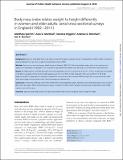Files in this item
Body mass index relates weight to height differently in women and older adults : serial cross-sectional surveys in England (1992–2011)
Item metadata
| dc.contributor.author | Sperrin, Matthew | |
| dc.contributor.author | Marshall, Alan David | |
| dc.contributor.author | Higgins, Vanessa | |
| dc.contributor.author | Renehan, Andrew | |
| dc.contributor.author | Buchan, Iain E. | |
| dc.date.accessioned | 2016-02-15T13:10:15Z | |
| dc.date.available | 2016-02-15T13:10:15Z | |
| dc.date.issued | 2016-09-17 | |
| dc.identifier | 209452680 | |
| dc.identifier | 343e323c-c673-43ea-a03a-1fb1d135dff8 | |
| dc.identifier | 84996551475 | |
| dc.identifier.citation | Sperrin , M , Marshall , A D , Higgins , V , Renehan , A & Buchan , I E 2016 , ' Body mass index relates weight to height differently in women and older adults : serial cross-sectional surveys in England (1992–2011) ' , Journal of Public Health , vol. 38 , no. 3 , pp. 607-613 . https://doi.org/10.1093/pubmed/fdv067 | en |
| dc.identifier.issn | 1741-3842 | |
| dc.identifier.uri | https://hdl.handle.net/10023/8231 | |
| dc.description | This study was partly supported by the University of Manchester’s Health eResearch Centre (HeRC) funded by the Medical Research Council (MRC) Grant MR/K006665/1 and partly funded by the ESRC Obesity eLab Grant (RES-149-25-1076). | en |
| dc.description.abstract | Background Body mass index (BMI) tends to be higher among shorter adults, especially women. The dependence of BMI–height correlation on age and calendar time may inform us about temporal determinants of BMI. Methods Series of cross-sectional surveys: Health Survey for England, 1992–2011. We study the Benn Index, which is the coefficient in a regression of log(weight) on log(height). This is adjusted for age, gender and calendar time, allowing for non-linear terms and interactions. Results By height quartile, mean BMI decreased with increasing height, more so in women than in men (P < 0.001). The decrease in mean BMI in the tallest compared with the shortest height quartile was 0.77 in men (95% CI 0.69, 0.86) and 1.98 in women (95% CI 1.89, 2.08). Regression analysis of log(weight) on log(height) revealed that the inverse association between BMI and height was more pronounced in older adults and stronger in women than in men, with little change over calendar time. Conclusions Unlike early childhood, where taller children tend to have higher BMI, adults, especially women and older people, show an inverse BMI–height association. BMI is a heterogeneous measure of weight-for-height; height may be an important and complex determinant of BMI trajectory over the life course. | |
| dc.format.extent | 7 | |
| dc.format.extent | 205115 | |
| dc.language.iso | eng | |
| dc.relation.ispartof | Journal of Public Health | en |
| dc.subject | Adiposity | en |
| dc.subject | Body height | en |
| dc.subject | Body mass index | en |
| dc.subject | Body weight | en |
| dc.subject | Health survey for England | en |
| dc.subject | Stature | en |
| dc.subject | Weight for height | en |
| dc.subject | RA0421 Public health. Hygiene. Preventive Medicine | en |
| dc.subject | GF Human ecology. Anthropogeography | en |
| dc.subject | 3rd-DAS | en |
| dc.subject | SDG 3 - Good Health and Well-being | en |
| dc.subject.lcc | RA0421 | en |
| dc.subject.lcc | GF | en |
| dc.title | Body mass index relates weight to height differently in women and older adults : serial cross-sectional surveys in England (1992–2011) | en |
| dc.type | Journal article | en |
| dc.contributor.institution | University of St Andrews. Geography & Sustainable Development | en |
| dc.identifier.doi | https://doi.org/10.1093/pubmed/fdv067 | |
| dc.description.status | Peer reviewed | en |
This item appears in the following Collection(s)
Items in the St Andrews Research Repository are protected by copyright, with all rights reserved, unless otherwise indicated.

